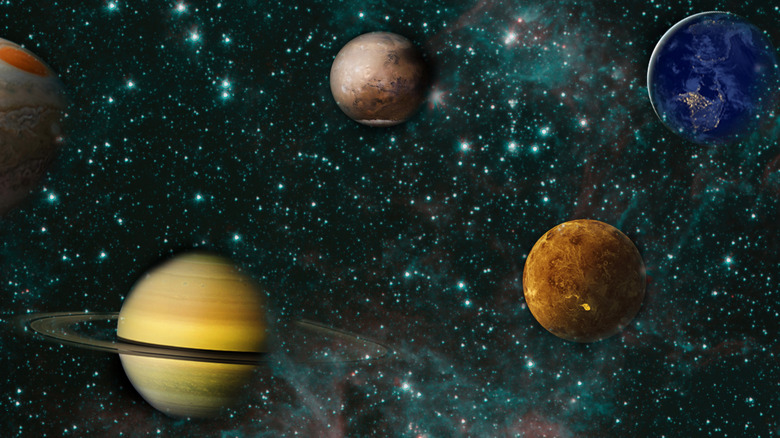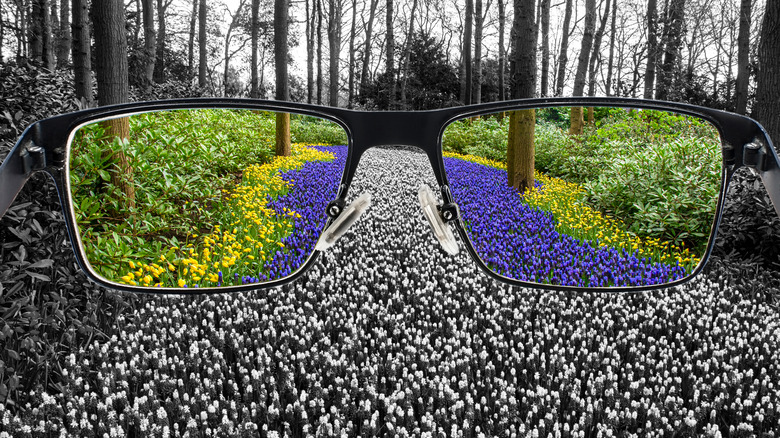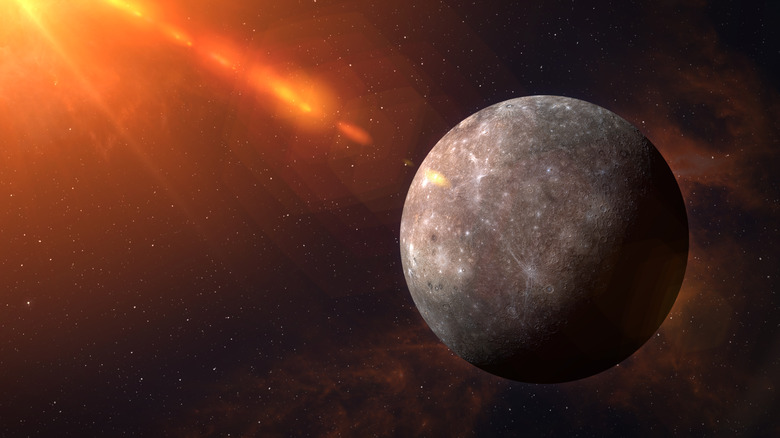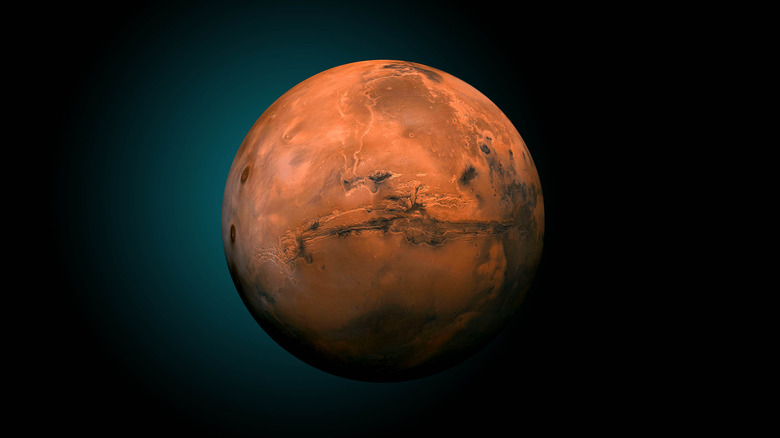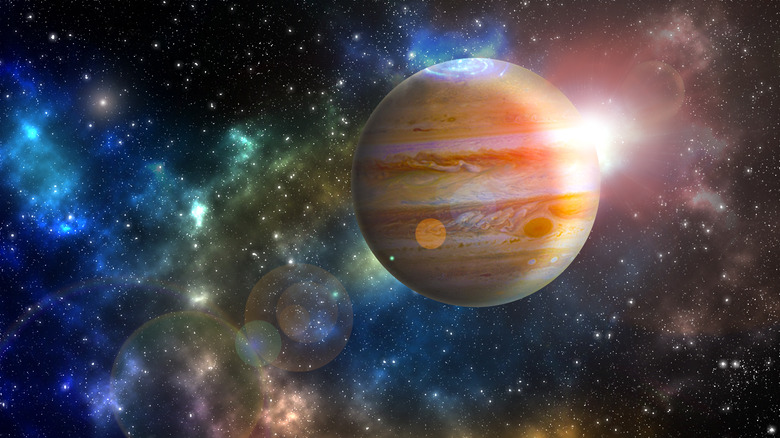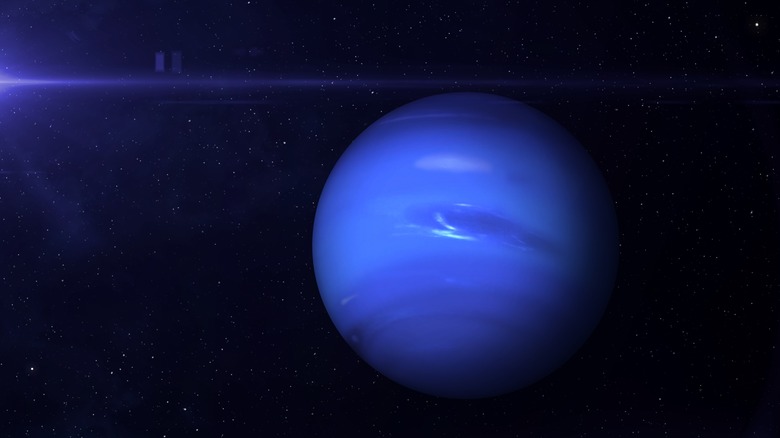Here's Why Planets Are Different Colors
Color plays an important part in the way we view the world. From our windows, we can see a plethora of shades. Intense yellows pour from the midday sun while green blades of grass shoot up from the ground. A myriad of hues surrounds us from burnt orange leaves to crimson-colored flowers, from crisp snowy whites to pitch-black concrete, and so forth.
But when we view the world as spectators through telescopes in the sky, it gleams as a two-toned sphere of blue and green (via NASA). This is because Earth is 71% water (per USGS) and land from a distance appears mostly as the tops of green trees. The other colors of our world are there in fine detail, but they are washed out by the most prominent shades spanning the globe. Making things even more interesting, not only does our planet look like a different color from space than what we see up close, but every other planet in the solar system bears its own unique hue.
They're in the same space circling the same hot sun, so why are the planets different colors? As it turns out, multiple factors contribute to this phenomenon.
Color is a message between the eye and the brain
When we think about color, we see it as merely a visual clue. In reality though, color is not so much a tangible object as it is a message being passed between the human brain and eye. According to Pantone, color perception is the way our brains translate light absorption. So, while we perceive an apple as "red" the vibrant shade we see is really just our eye telling our brain that the object -– in this case, an apple –- is reflecting a specific wavelength of light. Each object is painted a different color by our brains as a way of labeling the amount of light said object reflects.
Here on Earth, our light receptor cells translate about a million colors surrounding us on every side. From space, the perspective of light reflection paints a portrait of the most intense of these shades, namely blue and green. NASA reports that from the vantage point of the International Space Station, cameras can also capture yellow desserts and crisp white mountainsides. This is all a matter of angle, light, and perspective. But what about other planets' colors? What makes Mars red and Saturn a pale yellow-orangish tone?
Colors of planets depend on each planet's unique composition
According to Cool Cosmos, one of the factors that impacts the color of each planet is the material found on the surface of the ground. For example, Mercury's terrain is mostly comprised of the carbon-rich material we recognize as graphite (per The Verge). Through a telescope, the jagged graphite surface appears slate gray, as if someone sketched the planet out in pencil and then forgot to color it in. This gray is not to be confused with the gray color of the moon, which is a result of iron, not graphite.
According to scientists, Mercury's graphite patches are not only found on the surface of the planet. They are also likely underneath the planet's crust, a subtle cue to what the planet looked like in the past. As you can see, the factors that derive a planet's color aren't just visible on the ground, but they are also sometimes buried underneath the surface. If you dig a little deeper into this awe-inspiring visual science, you'll see that color is equally impacted by components hovering over each planet's surface as well.
Each planet's atmosphere contributes to its hue
Cool Cosmos reports that like surface materials, atmospheres also impact light reflection and absorption. This too contributes to each famous planetary hue. The contrasting burnt orange and pale yellow attributes that we associate with planet Venus, for example, are emblematic of the dense layers of carbon dioxide and sulfuric acid hanging about the planet's atmosphere.
NASA reports that Uranus takes its cool blue hue from the small amounts of methane in its atmosphere. Interestingly enough, the methane on Uranus is actually absorbing a red light but reflecting it back into space as blue (via Cool Cosmos).
Speaking of red, Mars, the planet which is notorious for its fiery red appearance takes its tone from both its atmosphere and its surface material. According to Space, Mars is abundant in iron from its surface to its core, which many scientists believe is a result of its smaller size and weaker gravity. Under different circumstances, all that iron would cause the planet to appear gray. However, Mars exhibits an atmosphere ripe with oxygen and when the iron becomes oxidized, it takes on a rusty red color tone.
Intense storms can change the color of planets
When we think of a planet's color, we wrongfully envision an unchanging hue piercing through the vastness of space. However, because color is perceived as light is reflected or absorbed, this means that intense storms can change a planet's color as winds shift through the atmosphere. In other words, a planet's color isn't necessarily set in stone, particularly if the planet in question has some wacky weather phenomenon going on.
According to Universe Today, this is exactly what is happening on Jupiter. The cosmic gas giant is notorious for its storms. Many are aware of the Great Red Spot on the planet that is really just a massive vortex 400 years in the making (via NPR). What you might not know is that other colors witnessed on this planet are also the result of inclement weather. The brown spots are believed to be warm storms shifting through the clouds, whereas the white sections are storms with cooler winds. Business Insider reports that some stormy sections of Jupiter fluctuate in color all the time, shifting from red to white depending on the temperature of each storm's core.
Thickness of cloud cover and haze play a role in the color scheme too
NASA reports that planets can have startlingly similar attributes and still be different colors, as we have witnessed in the examples of Uranus and Neptune. These two planets exhibit roughly the same appearance in terms of material, mass, atmosphere, and even size. Given the above-listed observations, they should really be the same color when viewed from space. However, they are different shades of blue, with Neptune being much more vibrant and Uranus boasting a muted shade of blue. New research suggests the difference is caused by the fact that Uranus produces a thicker layer of haze that hovers the planet and makes its blue color appear duller, at least to the human eye.
Speaking of the human eye, it's notable to mention that our light perception is limited, making us blind to many of the colors in the universe. According to NASA, our telescopes are designed to capture fractions of infrared and ultraviolet wavelengths that are rendered invisible to the human eye but visible to other Earth creatures like birds, bullfrogs, and butterflies. Yet even this advanced technology does not capture the full light spectrum, meaning all the planets might be completely different colors from what we mere mortals see.
